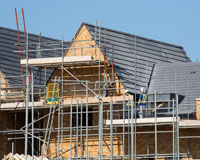 The housing crisis across the UK is ongoing, and the property shortage in London is steadily increasing. With the capital’s population set to reach 10m people in the next 20 years, demand is unlikely to ease.
The housing crisis across the UK is ongoing, and the property shortage in London is steadily increasing. With the capital’s population set to reach 10m people in the next 20 years, demand is unlikely to ease.
While this issue may be most prominent in London, population growth will have an impact on all of our cities, towns and villages. The Office of National Statistics expects an increase of 4.4m people over the next decade, rising to 69m by 2024.
The challenge is that, on average, only 25,000 dwellings have been delivered each year in London over the past decade – nowhere near enough to meet the inevitable surge in demand.
Recently at GL Hearn we came up with a solution to the increasing problem with the creation of a “MegaPlan for a MegaCity” – one of the ten winners of the NLA’s New Ideas for Housing London competition.
The premise is that London will become the first city in western Europe to have a population of 10m by 2035 and that key to creating a sustainable long-term growth strategy is to fully consider and appropriately maximise all potential sources of land supply.
This includes land within and at the edge of existing settlements, in a manner that conforms to national policy.
We are advocating such an approach for London, by implementing a radical step-change in housing delivery to meet housing targets. But the overarching strategic approach to assess and identify land at settlement edges is by no means limited to the capital.
It has already been adopted in Greater Manchester, where the 10 boroughs have joined up to create a new spatial framework for the city region, and should be utilised further.
The strategy complements the “up before out” approach, alongside compact city principles that intend to deliver growth within existing urban areas.
In London, examples include New Covent Garden Market and Nine Elms, where more than 60 acres of under-utilised land will be transformed to provide a mix of employment and commercial uses, as well as more than 3,000 new homes. In Croydon too, densification is helping to deliver a range of benefits.
There is no silver bullet to solve the housing crisis, but the “MegaPlan” would aim to maximise the potential contribution of edge land up to the M25 to provide a long-term strategy.
And though three-quarters of this land is green belt, less than 4% would be needed to meet the current housing shortfall.
Clearly, such an approach would have to be underpinned by a strategic green belt review to positively plan for growth and protection, focused around parkland and activity corridors. But aspirations both for growth and protection would be held in equally high regard for the sake of London’s success.
The green belt review would assess all land up to the M25 against the five National Planning Policy Framework purposes. Findings would illustrate the role and function of the land and its level of contribution towards
national policy.
This would highlight the minority of land making the least contribution, which would then be subject to a second stage assessment to consider non-green belt factors such as housing needs, affordability, value, accessibility, and deliverability to ultimately test sustainability.
The constrained nature of the city and surroundings must be dealt with head-on if London is to meet its own housing needs. Using edge land provides a platform for consistent planning across London boroughs and adjoining LPAs to carefully allocate sites in the most suitable locations.
This approach would not give rise to urban sprawl and represents an alternative to ongoing tentative and
small-scale chipping away of the green belt.
For London, only through a long-term and strategic plan can our great city become not only the first MegaCity in western Europe, but the best in the world that has room to accommodate all.
Roland Brass is associate director at GL Hearn, part of Capita Real Estate










